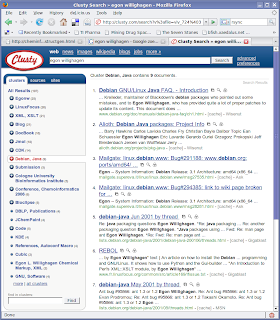Have had great time today at Colorado State University talking to the Library and Information Scientists. Lost of ideas, especially on the role and construction of Institutional Repositories. I am still revising my views about this and feel that the classic model (if anything 3 years old can be classic) where scholars deposit a finished digital gem may not be the only one.
In preparing my presentation I looked around for repository models and suddenly realised I had been using one for years – Sourceforge. This is an ideal model, as long as you accept the tenet of Open Source (not the same as Open Access, but philosophically aligned). SF is a repository for computer code and manages complete version control and also a complete collaborative environment. I make a change to the code – it gets a new version number, but also I can still retrieve all previous versions. Also Any of my collaborators can make changes and I update seamlessly to include all their enhancements. So why not use the same software – SVN – to manage our repositories.
Publishing a scholarly manuscript is a complex workflow. (OK, I’m a coward and usually find a co-author who does it for me). It goes like this:
- Author A writes a draft and circulates it to B and C (at a different institution)
- B makes some changes
- C makes some changes
- A updates with B’s changes
- D (oh, yes, we can change the authorship) edits A’s original manuscript
- there are now at least 3 versions of the manuscript circulating
- A prints them all out and tries to reconcile changes
- etc.
- finally F makes the finished version and sends it to the publisher
- publisher sends reviewers comments to F who forwards them to B and C
- C makes changes and resends them to F
- F sends revised draft to publisher
- A complains that s/he didn’t see the comments
- F sends further revised draft to publisher
- weeks pass
- and some more
- X mails A saying why not put m/s in IR
- Publisher only allows reposition of author’s m/s pre-submission
- A mails F saying that publication has appeared
- mail bounces saying F has moved
- A tries to recover m/s from B, C and E (yes E was in it).
- A edits the mess into what might have been sent to publisher and mails to X
BUT using SVN it’s trivial – assuming there is a repository.
So we do not speak of an Institutional Repository, but an authoring support environment (ASE or any other meaningless acronym. )
A starts a project in institutional SVN.
B joins, so do C, D, E, etc.
They all edit the m/s. Everyone sees the latest version. The version sent to the publisher is annotated as such (this is trivial). All subsequent stuff is tracked automatically.
When the paper is published, the insitution simply liberates the authorised version – the authors don’t even need to be involved.
The attractive point of this – over simple deposition – is that the repository supports the whole authoring process.
If you want to start, set up SVN – it’s easy and there are zillions of geeks who know how to do it. It’s free, of course, and also very good. That’s it. It’s easiest if the authoring is done in LaTeX as then the diffs are obvious. But Word will probably do fine (modern word is saved as XML). Start with single authors – thesis candidates, humanities, etc.
====
I was also honoured to have a videocast interview which CSU will make available (under CC) soon. I have a few personal observations on Open Foo, the role of publishers, of libraries, etc.
